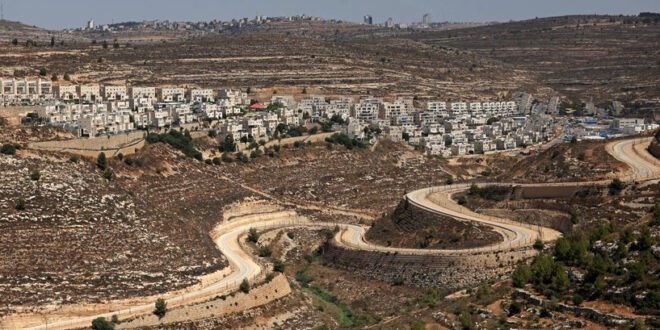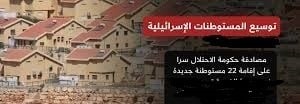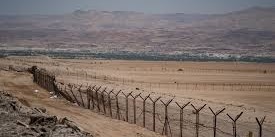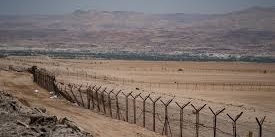By: Madeeha Al-A’raj
The national Bureau for Defending Land and Resisting Settlements stated in its latest weekly report , that several Israeli sources stated that the Occupation Authorities (OA) intend to approve the construction of 2,749 new settlement units in the West Bank within a month, and that the Supreme Planning Council in the occupation’s Civil Administration will begin its weekly meetings to consider plans for advancing the construction of new settlement units at high rates.
If approved this means a new wave of settlement expansion in the West Bank. According to its sources, the Israeli Peace Movement expects that the (OA) will build about 1,800 settlement units per month. It indicated that ‘the Supreme Planning Council, affiliated with the Israeli Civil Administration, is scheduled to hold a special meeting to approve the construction of 372 housing units in the Beitar Illit settlement’ south of Jerusalem.
Noting here that the Supreme Planning Council of the occupation’s ‘Civil Administration’ in the West Bank has approved the construction of 2,377 housing units in the settlements since the beginning of last December, including 400 housing units approved this month. According to Yedioth Ahronoth Newspaper’ in 2023, plans to build 12,349 housing units in the settlements were approved and 9,884 housing units in 2024, and will increase significantly.
According to the occupation government’s program and ‘Smotrich’s Plan’ the expansion in settlement comes in the wake of the Israeli Finance Minister and Minister of Settlement in the Ministry of Army’s decision for the Supreme Planning Council to hold weekly meetings for approving building plans, instead of holding a meeting every 3-4 months, as was previously the case. The transformation of the Supreme Planning Council meetings into weekly meetings aims to significantly increase the approval of building plans in the settlements, and their expansion, during the year 2025 compared to previous years. The amendments to the Civil Administration’s policy were not limited to the weekly meeting alone, but also extended to the political reference for approving settlement construction.
The Supreme Planning Council used to meet every three or four months or more by government decision, and approving construction in the settlements required the approval of the Minister of Army and the PM Netanyahu. In the past, settlement plans went through two stages: the first was planning, which went through about 10 stages, and the second was implementation, which went through 7 stages, including obtaining approvals from various governmental and non-governmental bodies, ending with obtaining the approval of the Minister of Army and the PM.
Thus, the meeting of the Supreme Planning Council for Settlements in the Civil Administration no longer requires government approval, and the approval of the decisions of this council no longer requires a prime minister. Everything has changed and the powers have been transferred to Smotrich. He decides the date of the meeting and approves the building plans and tenders for the construction of housing units in the settlements. Netanyahu gave up all of these powers to maintain the cohesion of his government and to remain in power by bribing Smotrich and appointing him as a political reference for all settlement activities and plans in the West Bank.
These transformations aren’t new, nor it a result of the brutal war on the Gaza Strip, as well as in the West Bank, including Jerusalem. It is not a deal in wartime conditions between Netanyahu and Smotrich, but rather it preceded the war. In July 2023, the Israeli government approved a decision stipulating that Smotrich alone would approve the advancement of construction plans in the settlements without the need for government approval, while before that, the Israeli government was the one that approved construction plans, through a system agreed upon with the United States, according to the Israeli newspaper Yediot Ahronot. The circumstances of the war made it easy for Smotrich to concentrate his powers and lay the necessary foundations for a massive settlement wave in the West Bank.
With the genocidal war on the Gaza Strip, Smotrich supported by Ben Gvir, from within the far-right government led by Netanyahu, has devoted himself to waging a war on the Palestinian presence in the West Bank, which Israeli experts say aims to impose forced displacement on the Palestinians and build a ‘settler state’ in the West Bank. It is known that Ben Gvir, who lives in the ‘Kiryat Arba settlement’ in Hebron, and holds the position of Minister of National Security; and controls the police apparatus and law enforcement in the West Bank, is the right-hand man of Minister Smotrich, who seeks primarily to control the land, and he works within the framework of the opinions of the rabbis to whom he belongs, while Ben Gvir is an extremist nationalist who holds the ideology of the fascist ‘Kach Movement’ founded by Rabbi Meir Kahane, and bends religion to serve his interests and policies based on inciting violence and displacing the Palestinians. Ben-Gvir leads a nihilistic terrorist movement, while the movement led by Smotrich is led by rabbis, who have great influence on the religious people.
Since becoming a Minister, Smotrich has increased the confiscation of Palestinian lands under various names, such as, state property or nature reserves, and has classified large areas of land as nature reserves, which has led to their confiscation and the prevention of Palestinians from accessing them. According to a report by the ‘Haaretz’ in 2023 the Civil Administration evacuated large areas of land extending from east of Ramallah to the outskirts of Jericho of Palestinian residents, by encouraging organized attacks carried out by Jewish terrorist militias supported by the government and the army. The land, according to the newspaper, is about 150,000 dunams in area, equivalent to three times the area of the Tel Aviv Municipality.
Within the context, the Israeli human rights organization ‘Kerem Navot’ confirms that a large part of the lands confiscated by Israel in that area were classified as a military training area, which Palestinians are prohibited from accessing or being in, as they were transferred to the settlers, who established settlement outposts and terrorist pastoral farms there.
On another level, the Jerusalemites are facing difficult circumstances in confronting the occupation government’s policy on two levels: the first is confronting the policy of demolishing homes, and the second is confronting the expansion projects of settlement activities with various and multiple projects. These days, they are facing the largest colonial settlement project in the city, which threatens to evacuate their facilities in preparation for demolition and seizing hundreds of dunams in the Wadi al-Joz Neighborhood. According to a report issued by the Jerusalem Governorate, the ‘Silicon Valley project’, which has once again strongly threatens to seize 2,000 dunams of Palestinian land in the Wadi al-Joz Neighborhood, is currently under discussion.
The Silicon Valley settlement project extends along Wadi al-Joz Road and Othman bin Affan Street, and 8 to 14 floors will be built on the ruins of commercial and industrial shops in the Jerusalem industrial zone in Wadi al-Joz. It is worth noting here that the occupation authorities in Jerusalem announced on the 9 this month the start of implementing the ‘Silicon Valley settlement project’ in the aforementioned neighborhood, which threatens to demolish about 200 facilities and confiscate 2,000 dunams.
The Silicon Valley project in the Wadi al-Joz Neighborhood of the city is accompanied by a broad aggression by the occupation authorities and municipality against the Jerusalemites in the Batn al-Hawa Neighborhood in Silwan. Last week, Jerusalem Magistrate Court’ Judge, Mariam Kaslisi issued rulings in four eviction lawsuits filed by settlers against Palestinians in that neighborhood. A ruling is expected in the fifth case in the coming days.
The Peace Now movement considered the eviction part of a larger effort to forcibly displace an entire community of about 700 Palestinians from this neighborhood in East Jerusalem and establish a settlement in the place, as the Ateret Cohanim settlement association claims that 5 dunams and 200m2 of Batn al-Hawa land have been owned by Jews from Yemen since 1881. The town of Silwan is one of the most targeted and threatened towns in Jerusalem, either with the demolition of its homes or the forced eviction and displacement of its residents, in favor of the settlement associations, especially since more than 40% of its buildings are threatened with demolition, on the pretext that they are ‘illegal.’
Within the context, data from (OCHA) indicate that the occupation authorities demolished 215 buildings in East Jerusalem in 2024. Based on this data, the highest number of demolitions was in the Silwan town, where 41 buildings were demolished, followed by Jabal Mukaber 34, Al-Walaja 27, Al-Issawiya 24, Beit Hanina 17, At-Tur 11, Sur Baher 10, Ras Al-Amud 9, Shuafat 9, Wadi Al-Joz 8, Ath-Thawri 5, Shuafat Camp 4, Beit Safafa 3, Al-Zaim 3, Bab Al-Sahira 2 and Bir Ona 2, the Old City 2, Al-Qanbar 2. The number rises to 402 if the Jerusalem Governorate area is included, as Anata, Hizma, Sur Baher, Al-Zaim, Biddu, Rafat, Nabi Samwil and Beit Anan witnessed extensive demolitions.
Moreover, the Israeli General Security Service ‘Shin Bet’ warned of its security implications on the situation in the West Bank, the Minister of the Occupation Army, Yisrael Katz, cancelled the administrative detention orders against 7 terrorist settlers, who were being held administratively, over the weekend, due to the expected release of Palestinian prisoners, including the terrorist settler Itiel Ben Tzruya, against whom his predecessor, Yoav Galant, had issued a 6-month administrative detention order following his participation with a hundred terrorist settlers in burning Palestinian property in the village of Yatma and attacks in the village of Jit last August, which resulted in the martyrdom of the young man Moh’d Abd al-Qadir Sidah. Katz explained that ‘in light of the expected release of “Palestinian prisoners” as part of the hostage release deal, I have decided to release the administratively detained settlers and to send a clear message of strengthening and encouraging settlement’.
List of Israeli Assaults over the Last Week Documented by the National Bureau:
Jerusalem:
- Demolishing the foundations of a house belonging to Abdul Salam Fazaa Al-Omari, a carpentry shop belonging to Moh’d Khaled Al-Khatti, and an agricultural room, and stone walls and chains were razed in the town of Hizma, northeast of occupied Jerusalem, and notices were issued to demolish houses and facilities in the town of Silwan. Moreover, they demolished the Samreen family house in the Silwan town at their own, by a decision from the occupation municipality under the pretext of not having a permit.
- Handing over a demolition order in the Wadi Al-Rababa Neighborhood in Silwan belonging to the Baydoun family to demolish part of a building that was recently added to an old house under the same pretext.
Hebron:
- Demolishing order of a sheep barn in Khallet al-Fara, west of Yatta, south of Hebron, belonging to Ibrahim al-Harini, and notified the cessation of work on several houses belonging to the brothers Ra’fat, Saher, and Issa Moh’d Harb, in addition to a notice to stop work on a barn belonging to Ibrahim Akash al-Harini.
- Beating Sae’d al-Amour in Khirbet al-Rakeez and released their sheep to graze around his house in the Masafer Yatta.
- Uprooting about 50 olive trees in the Huwara area, east of Yatta, belonging to Omar Aql al-Jabour, besides smashed and broke solar cells that generate electricity.
- Attacking citizens’ homes in the Susya village, and stormed the old city of Hebron, chanted racist slogans against Arabs.
- Assaulting a foreign activist and released their cattle to graze on citizens’ lands in the Fatah Sidra area in Masafer Yatta, stormed the archaeological site of Tell Ma’in in the Carmel town, south of Hebron.
Bethlehem:
- Seizing 7 dunams of land from the Hussan village in the ‘Al-Haraik’ area, adjacent to the “Beitar Illit” settlement. The land belongs to citizens Ayed Odeh Shosha and Ahmed Mahmoud Shahin.
- Uprooting 200 olive seedlings belonging to citizen Hussein Shakarna and his cousin in the Ein Fares area west of the Nahalin town, located between the ‘Beitar Illit’ settlement and the villages of Wadi Fukin.
- Assaulting a number of farmers in the Al-Minya village, east of Bethlehem, and stole their livestock.
- Stealing shops and nurseries on the main street in the Taqo’a town.
- Assaulting farmers and burned their tents for raising livestock in the ‘Deir Alla’ area.
Ramallah:
- Injuring several citizens while storming the Turmusaiya town, north of Ramallah, while others attempted to burn a number of homes and vehicles of citizens in the town.
- Burning a farm belonging to the Abu Falah town, and wrote racist slogans including ‘Death to Arabs and Revenge’.
- Forcing citizens to leave their lands in the Al-Mughayir village, in the ‘Al-Khalayel’ area, in favor of settlement outposts established near the place.
- Attacking citizens from Shuqba, northwest of Ramallah, while they were working on their agricultural lands north of the village, and burned a citizen’s vehicle there, and attacked a citizen’s vehicle near the Turmusaiya village.
Nablus:
- Bulldozing the bypass road between Ramallah and Nablus that serves the villages of Qabalan, Yitma, Jurish, Talfit, Jalud and Qaryut, south of Nablus. It was used as an alternative road to the Nablus-Ramallah-Jerusalem line, when the main road passing near the villages of Al-Sawiya and Al-Lubban Al-Sharqiya was closed.
- Bulldozing the lands in the Madama town adjacent to the bypass road north of the town, while closing all its entrances, before proceeding to bulldoze lands and uproot olive trees, attacked the houses on the outskirts of the town.
- Attacking citizens’ vehicles after the Za’tara military checkpoint, on the road between the cities of Nablus and Ramallah, and forced citizens to stop their vehicles and sprayed them with pepper gas.
- Shooting a boy in his foot in the Yatma village with live ammunition after settlers attacked the houses in the village, cut down dozens of olive trees in the eastern Lubban area in the Saria area, southeast of the village.
- Paving a layer of ‘basecorse’ on lands in the Naqoura village in preparation for establishing a settlement outpost in the Ein Qibla area, and threatened if any citizen approached the place, they would destroy all the nearby greenhouses belonging to Palestinian farmers.
Qalqilia:
- Demolishing a house under construction of 150m2, belonging to citizen Hamouda Muhaisen in the Al-Fonduq village,, and a commercial store with an area of half a dunam, under the pretext of not having permits. They also demolished an agricultural facility containing a barn, a greenhouse, and a water tank, belonging to citizen Moh’d Amin Taym, built on 4 dunams, which caused huge material losses.
- Storming the main entrance to the Immatin village, and began to bulldoze areas of land there.
Jordan Valley:
- Attacking the Qa’un Plain area in Bardala village to the northern Jordan Valley, cut down and broke olive trees belonging to Sultan Rashid Sawafta over an area of 10 dunams, and caused great damage to the farm.
- Preventing citizens from plowing and cultivating their lands, while notifying 16 residential and agricultural facilities belonging to 5 families in Ras al-Ahmar in the Jordan Valley to stop work, under the pretext of not having a permit.
- Storming the al-Auja Shalal community, north of Jericho, and released their flocks to graze in the pastures and crops of citizens, which are a major source of income for Bedouin families in the area.
 المكتب الوطني للدفاع عن الارض ومقاومة الاستيطان منظمة التحرير الفلسطينية
المكتب الوطني للدفاع عن الارض ومقاومة الاستيطان منظمة التحرير الفلسطينية




